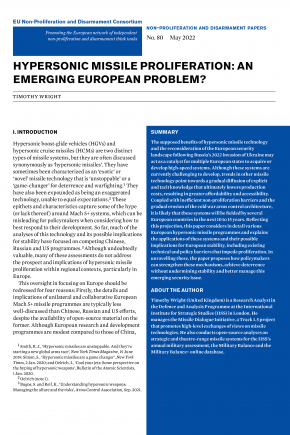Hypersonic Missile Proliferation: An Emerging European Problem
The supposed benefits of hypersonic missile technology and the reconsideration of the European security landscape following Russia’s 2022 invasion of Ukraine may act as a catalyst for multiple European states to acquire or develop high-speed systems. Although these systems are currently challenging to develop, trends in other missile technology point towards a gradual diffusion of explicit and tacit knowledge that ultimately lowers production costs, resulting in greater affordability and accessibility. Coupled with inefficient non-proliferation barriers and the gradual erosion of the cold war arms control architecture, it is likely that these systems will be fielded by several European countries in the next 10 to 15 years. Reflecting this projection, this paper considers in detail various European hypersonic missile programmes and explains the applications of these systems and their possible implications for European stability, including existing technical and policy barriers that impede proliferation. In unravelling these, the paper proposes how policymakers can strengthen these mechanisms, achieve deterrence without undermining stability and better manage this emerging security issue.
I. Introduction
II. Hypersonic flight, technology, and applications
III. European hypersonic missile programmes
IV. Implications for European stability
V. Technical and policy barriers to hypersonic proliferation
VI. Conclusions and recommendations to manage proliferation and limit instability

